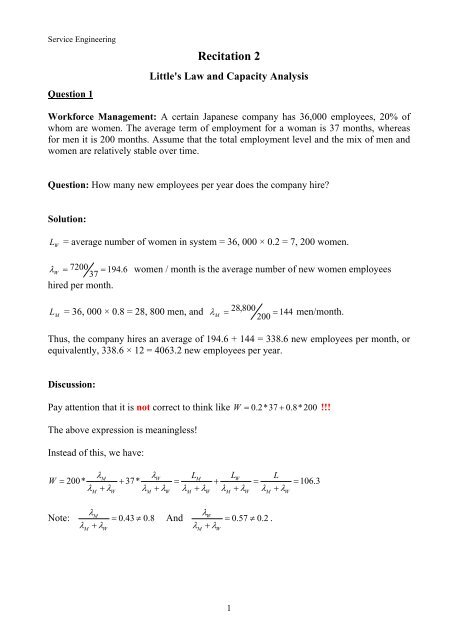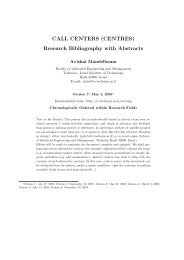Recitation 2
Recitation 2
Recitation 2
Create successful ePaper yourself
Turn your PDF publications into a flip-book with our unique Google optimized e-Paper software.
Service Engineering<br />
Question 1<br />
<strong>Recitation</strong> 2<br />
Little's Law and Capacity Analysis<br />
Workforce Management: A certain Japanese company has 36,000 employees, 20% of<br />
whom are women. The average term of employment for a woman is 37 months, whereas<br />
for men it is 200 months. Assume that the total employment level and the mix of men and<br />
women are relatively stable over time.<br />
Question: How many new employees per year does the company hire?<br />
Solution:<br />
L W = average number of women in system = 36, 000 × 0.2 = 7, 200 women.<br />
λ 7200<br />
W = = 194.<br />
6 women / month is the average number of new women employees<br />
37<br />
hired per month.<br />
L M = 36, 000 × 0.8 = 28, 800 men, and λ 28,<br />
800<br />
M = = 144 men/month.<br />
200<br />
Thus, the company hires an average of 194.6 + 144 = 338.6 new employees per month, or<br />
equivalently, 338.6 × 12 = 4063.2 new employees per year.<br />
Discussion:<br />
Pay attention that it is not correct to think like W = 0.2*37 + 0.8*200 !!!<br />
The above expression is meaningless!<br />
Instead of this, we have:<br />
λM<br />
λW<br />
LM LW<br />
L<br />
W = 200* + 37* = + = = 106.3<br />
λ + λ λ + λ λ + λ λ + λ λ + λ<br />
M W M W M W M W M W<br />
λM<br />
Note: = 0.43 ≠0.8<br />
λ + λ<br />
M W<br />
λW<br />
And = 0.57 ≠0.2<br />
.<br />
λ + λ<br />
M W<br />
1
Question 2<br />
MBPF Finance Inc. makes loans to qualified buyers of prefabricated garages from its<br />
parent company, MBPF Inc.<br />
Having just re-engineered its application-Processing operations, MBPF Finance is now<br />
evaluating the effect of its changes on service performance. The subsidiary receives about<br />
1000 loan applications per 30-day working month and makes accept/reject decisions based<br />
on an extensive review of each application.<br />
Prior to January 1998 (under “Process 1”) MBPF Finance Processed each application<br />
individually. On Average, 20% of all applications received approval. An Internal audit<br />
showed that, on average, MBPF Finance had about 500 applications in Process at various<br />
stages of the approval procedure, but on which no decisions had yet been made.<br />
In response to customer complaints about the time taken to Process each application,<br />
MBPF hired a consultants company that suggested the following changed to the Process,<br />
thereby creating “Process 2”.<br />
1. Because the percentage of approved applications is fairly low. An initial Review<br />
Team should be set up to preprocess all applications according to strict but fairly<br />
mechanical guidelines.<br />
2. Each application would fall into one of three categories: (A) looks excellent (B)<br />
needs more details evaluation (C) reject. Type A and B applications would be<br />
forwarded to different specialist subgroups.<br />
3. Each subgroup would then evaluate the applications in its domain and make accept /<br />
reject decisions.<br />
Process 2 was implemented on an experimental basis. The company found that, on average,<br />
25% of all applications were of type A, 25% were of B and 50% were of C. Typically,<br />
about 70% of type A and 10% of type B were approved on review. Internal-audit checks<br />
further revealed that, on average, 200 applications were with the Initial Review Team<br />
undergoing pre-Processing. Only 25 were with the subgroup A Team undergoing the next<br />
stage of Processing and approximately 150 were with the subgroup B Team.<br />
Graphically Process 2 can be described by the following flow chart:<br />
2
1000/month<br />
Initial<br />
Review<br />
LIR=200<br />
Questions:<br />
a) What was the service level under Process 1 – i.e. what was the average Processing<br />
time for a request?<br />
b) What is the average Processing time of a request under Process 2 ?<br />
c) Did the service level for approved requests improve in the transition from Process 1<br />
to Process 2 ?<br />
25%<br />
50%<br />
25%<br />
Subgroup<br />
A Review<br />
LA =25<br />
Subgroup<br />
B Review<br />
LB =150<br />
d) Assume now that 5 Insurance Agents are working in subgroup A (and they share the<br />
load evenly). Each agent can handle, on average, 75 requests per month. What is the<br />
average utilization level of the agents in subgroup A? Similarly, assume also that<br />
there are 8 agents in subgroup B, each capable of handling 40 requests per-months.<br />
What is the average utilization level of the agents in subgroup B?<br />
e) Assume now that, on average, 20% of the requests sent initially to subgroup A need<br />
in fact more detailed processing. These requests are sent to B after they complete the<br />
processing at A. What is now the utilization level of B agents?<br />
f) What is the utilization profile of agents in B, That is, what are the fractions of time,<br />
in the long run, that they allocate to requests from Initial Review, to requests from<br />
A, and what is the fraction of idle time?<br />
3<br />
70%<br />
30%<br />
10%<br />
90%<br />
Accepted<br />
Rejected<br />
200/month<br />
800/month
Solution:<br />
a) According to Little’s law the average Processing time would be 500/1000=0.5<br />
month or 0.5*30=15 days.<br />
b) Under Process 2 the average requests undergoing Processing is LIR+LA+LB=375. So<br />
the average Processing time is 375/1000=11.25 days. Or, if we look at the different<br />
“Processing stations” we have that<br />
W (IR) = 200/1000 = 0.2= 6 days.<br />
W (A) = 25/ (1000*0.25) =0.1= 3 days.<br />
W (B) = 150/ (1000*0.25) =0.6 = 18 days.<br />
And therefore the average Processing would be<br />
0 . 5*<br />
0.<br />
2 + 0.<br />
25*<br />
( 0.<br />
2 + 0.<br />
1)<br />
+ 0.<br />
25*<br />
( 0.<br />
2 + 0.<br />
6)<br />
= 0.<br />
375 = (* 30)<br />
= 11.<br />
25 days<br />
c) Note that for approved requests we have λ = 200 and all requests spend 0.2 in IR.<br />
25*<br />
0.<br />
7 + 150*<br />
0.<br />
1 17.<br />
5 + 15<br />
Hence W = 0 . 2 +<br />
= 0.<br />
2 + = 0.<br />
3625 = (* 30)<br />
= 10.<br />
875 days .<br />
200<br />
200<br />
Or, we can calculate<br />
200*<br />
0.<br />
25*<br />
0.<br />
7 + 200*<br />
0.<br />
25*<br />
0.<br />
1+<br />
25*<br />
0.<br />
7 + 150*<br />
0.<br />
1<br />
W =<br />
= 0.<br />
3625 = 10.<br />
875 days<br />
200<br />
So we see that the Processing time for approved requests did improve. However it is<br />
important to note that the averages do not tell the whole story and still all the<br />
approved requests going through B “enjoy” a 24 days processing time. That’s<br />
because<br />
15<br />
λ B = 1000 * 0.<br />
25*<br />
0.<br />
1 = 25 AndWB = 0 . 2 + = 0.<br />
8 = (* 30)<br />
= 24 days .<br />
25<br />
d) The input rate to A is 250 and the Processing capacity is 5*75 so the utilization level<br />
is 250/375=2/3.<br />
In the same way for subgroup B we have Utilization level = 250/ (8*40) = 250/320<br />
= 0.78125.<br />
e) Now we have the input rate for B is 250+50=300, so the utilization level of B would<br />
be 300/320=0.9375<br />
f) 250/320=78% of the time is dedicated to requests from Initial Review and<br />
50/320=16% of the time is dedicated to requests coming from A. Finally,<br />
20/320=6% of the time agents are idle.<br />
4
















